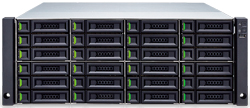RAID LEVELS
RAID LEVEL 1: | RAID 1: Mirroring & Duplexing | ACNC
For Highest performance, the controller must be able to perform two concurrent separate Reads per mirrored pair or two duplicate Writes per mirrored pair.
RAID Level 1 requires a minimum of 2 drives to implement

Characteristics & Advantages
- One Write or two Reads possible per mirrored pair
- Twice the Read transaction rate of single disks, same Write transaction rate as single disks
- 100% redundancy of data means no rebuild is necessary in case of a disk failure, just a copy to the replacement disk
- Transfer rate per block is equal to that of a single disk
- Under certain circumstances, RAID level 1 can sustain multiple simultaneous drive failures
- Simplest RAID storage subsystem design
Disadvantages
- Highest disk overhead of all RAID types (100%) - inefficient
- Typically the RAID function is done by system software, loading the CPU/Server and possibly degrading throughput at high activity levels. Hardware implementation is strongly recommended
- May not support hot swap of failed disk when implemented in "software"
Recommended Applications
- Accounting
- Payroll
- Financial
- Any application requiring very high availability




